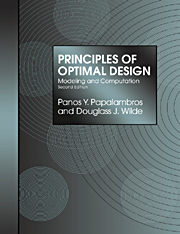6 - Parametric and Discrete Optima
Summary
Many are called, but few are chosen.
Matthew XXII, 14 (c. a.d. 75)In the previous two chapters we set out the theory necessary for locating local optima for unconstrained and constrained problems. From the optimality conditions we derived some basic search procedures that can be used to reach optima through numerical iterations. In Chapter 7 we will look at local search algorithms more closely. But before we do that we need to pick up the thread of inquiry for two earlier issues: the role of parameters and the presence of discrete variables.
One of the common themes in this book is to advocate “model reduction” whenever possible, that is, rigorously cutting down the number of constraint combinations and variables that could lead to the optimum – before too much numerical computation is done. This reduction has two motivations. The first is to seek a particular solution, that is, a numerical answer for a given set of parameter values. The second is to construct a specific parametric optimization procedure, which for any set of parameter values would directly generate the globally optimal solution with a minimum of iteration or searching.
If the variables are continuous, the most practical way to find a particular optimum for a single set of parameter values is simply to employ a numerical optimization code. When discrete variables are present, the resulting combinatorial problem can only be solved if we examine all possible solutions, directly or indirectly.
- Type
- Chapter
- Information
- Principles of Optimal DesignModeling and Computation, pp. 223 - 277Publisher: Cambridge University PressPrint publication year: 2000



